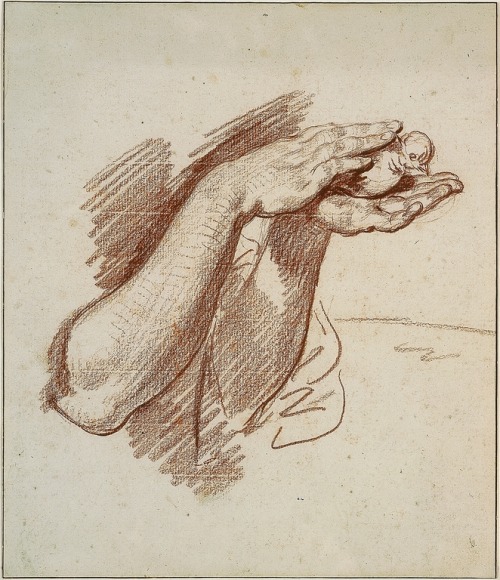Aspiring painters in 17th- and 18th-century France dreamed of studying at Paris’s Académie Royale de Peinture et de Sculpture (Royal Academy of Painting and Sculpture), one of the leading cultural institutions of the time. Instructors at the Académie emphasized the importance of life drawing, because mastery of the human figure was a vital skill for the successful painter. The Cantor Arts Center presents a selection of important drawings from the Renaissance and the 17th and18th centuries, when the influence of the Académie was at its peak, as well as some exemplary non-academic works from the 19th century, in “Storied Past: Four Centuries of French Drawings from the Blanton Museum of Art.” The show runs July 3 through September 22.
The Blanton, located at the University of Texas at Austin, organized the exhibition of 55 drawings primarily from its Suida-Manning collection. “Storied Past” chronicles the development of drawing in France from 1500 to 1900, a period of rapid innovation, tumultuous social revolutions and striking changes in artistic styles. Specifically, the exhibition explores the evolution of narrative subjects favored by the French tradition, as well as artists’ changing engagement with materials and techniques.
Strongly represented are 17th- and 18th-century drawings, which range from gestural sketches to more finished compositions. These drawings were not only the products of the Académie’s life-drawing classes, but also its lectures on religious, classical and mythological subject matter. The exhibition also highlights 19th- and early 20th-century works by draftsmen who reacted against the academic tradition. These artists deliberately took a more realist approach in their visual style and choice of subjects, and chose to render scenes of everyday life so as to communicate the social, economic, and political changes that were transforming modern France.
Showcased are drawings by famously talented draftsmen—among them Nicolas Lancret (1690–1743), François Boucher (1703–1770), Jean-Baptiste Greuze (1725–1805), Théodore Rousseau (1812–1867) and Théophile-Alexandre Steinlen (1859–1923). Apart from exploring the expressive and technical range of French drawing, the exhibition presents new research by curators and conservators about individual works’ histories, issues of connoisseurship and sheds light on drawing as an intellectual process.
The Cantor also presents four other exhibitions of French art this summer, from 16th-century representations of Fontainebleau to 19th- and 20th-century prints by Edouard Manet (1832–1883), Odilon Redon (1840–1916) and Henri Matisse (1869–1954).

Theophile-Alexandre Steinlen À l’atelier, circa 1895.
Graphite on wove paper. Gift of Alvin
and Ethel Romansky, 1978.
Blanton Museum of Art.
__Moroccan_Girl__Playing_a_Stringed_Instrument__1875-Pub..gif?1349644217)
Alexandre-Louis Leloir, Moroccan Girl, Playing a
Stringed Instrument, 1875. Watercolor, gouache
and graphite on ivory wove paper. 9 5/8 x 13
9/16 inches. Gift of the Wunsch Foundation, Inc.,
1983. Blanton Museum of Art.

Théodore Rousseau, A Marshy River Landscape, circa 1845. Charcoal
heightened with white chalk on pink laid paper. 9 3/16 x 16 15/16
inches. Gift of Mr. E. Wyllys Andrews IV, Charles and Dorothy Clark, Alvin
and Ethel Romansky, and the children of L. M. Tonkin, and University
purchase, by exchange, 2006. Blanton Museum of Art.

Jean-Baptiste Greuze, The Arms of a Girl Holding a Bird, circa
1765.Red chalk on cream laid
paper, laid down. The Suida-
Manning Collection. Blanton Museum of Art.
Henri-Joseph Hesse, Portrait of a Man,
1811. Brush with brown ink and white
heightening over traces of black chalk on
beige wove paper. 9 1/4 x 7 5/8 inches.
Archer M. Huntington Museum Fund, 1987,
1987.19. The Blanton Museum of Art.
Anonymous, Noah Leading the Animals
into the Ark, after Giovanni Benedetto
Castiglione, circa 1780. Brush with colored
oils on antique laid paper, laid down. 15 5/8 x
21 3/4 inches. The Suida-Manning Collection.

Charles-Antoine Coypel, France Thanking Heaven
for the Recovery of Louis XV, 1744. Black
and white chalks with brush and gray wash and
touches of red chalk on cream antique laid paper.
11 15/16 x 7 7/8 inches. Blanton Museum of Art,
Suida-Manning Collection.